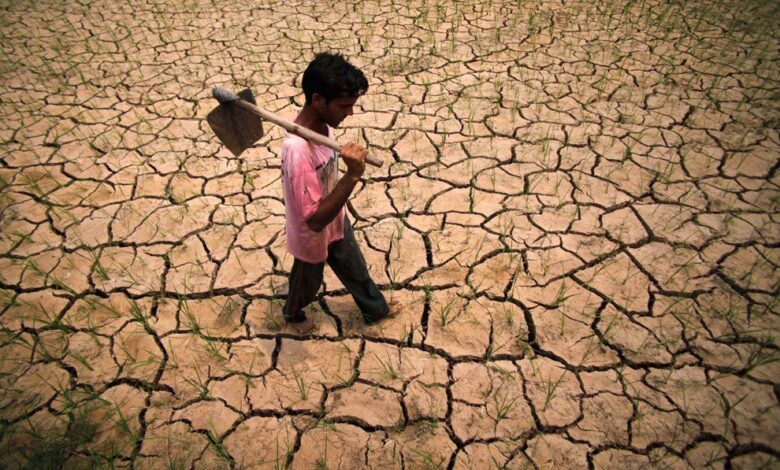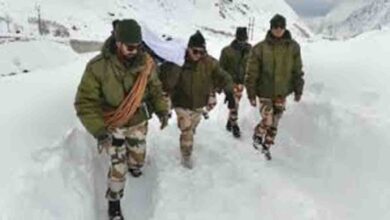The importance of rain and the threat of drought

GUEST COLUMN
 GS Rajwar
GS Rajwar
In the current climate change scenario in India why a single drop of water is so precious and why doesn’t a drought end when it rains? The answer to such questions lies in solving the problem of drinking water and water scarcity by facilitating rainwater infiltration into the soil for rejuvenation and recharge of the groundwater. The rainwater is not retained much and is not percolated deep into the soil on hill slopes and in desert areas. In such areas, the rain water flows away. A report of the American Geosciences Institute states that rainfall in any form will be a relief for the drought condition. A single dose of medicine can alleviate symptoms of illness, but it usually takes a longer time of medication to cure an illness. Similarly, a single rainstorm or precipitation will not break the drought, but it might provide temporary relief. The water sources in the Himalayan and other hilly areas get charged naturally by slow percolation of rainwater deep into the soil. A light to moderate precipitation may only provide cosmetic relief due to its short-term impact, but thunderstorms often cause large amounts of precipitation in a very short time, so most of the rain will run off into drainage channels and streams rather than soak into the ground. Soaking rain is the best medicine to alleviate drought through its percolating process. Water that percolates the soil recharges groundwater, which can provide water during non-rainy seasons. This process supports vegetation and recharges the water source, thereby the water including drinking water and stream water supply will continue in the summer and other seasons too in a year. This kind of relief is long-lasting from drought conditions, but many such rains over several months might be required to break a drought. The quantity of precipitation at a particular location varies from year to year, but the average quantity is fairly constant over the years. A drought may be defined as a period of drier-than-normal conditions that results in water-related or water scarcity problems. As predicted by some scientists, the long-term effects of climate change will include a decrease in sea ice and an increase in permafrost thawing, an increase in heat waves and heavy precipitation, and decreased water resources in semi-arid regions. One cannot easily determine the beginning of a drought. Several weeks, months, or even years might pass before people know that a drought is to happen. The first evidence of drought is usually seen in rainfall records and secondly, when the amount of moisture in soil begins to decrease.
Climate Analytics is a global climate science and policy institute engaged around the world in driving and supporting climate action aligned to the 1.5 degree Celsius warming limit. Their study, published in journal Nature Climate Change, shows that limiting global warming to 1.5 degree Celsius above pre-industrial levels in line with the Paris Agreement would largely avoid these additional impacts. This is the first study to show that, compared with today’s climate, the persistence of relatively warm, dry and rainy summer periods would increase in the temperate zone of the northern hemisphere if global temperatures rise by 1.5 degree Celsius and two degrees Celsius above pre industrial levels. With the warming of the earth the number of hot days increases. The increased persistence of warm weather combined with global warming will lead to much more severe heat waves in the future. This study also found that if the world warms to two degrees Celsius above pre industrial levels, there would be a significant shift in summer weather conditions from the patterns we know today. The results of the study indicate that extreme weather would become more persistent – hot and dry periods, as well as consecutive days of heavy rain would all get longer. The hot and dry weather extremes would adversely impact health, ecosystems, agriculture and the economy. The consecutive days of heavy rain would likely cause severe flooding. The climate models show a systematic weakening of the large-scale summer atmospheric circulation. The effect of climate change on the monsoon seasons is one of the important reasons for the decrease in rainfall and water shortage in India. In recent years, sporadic rains have occurred in India, thus reducing the total precipitation.
A report of Stockholm International Water Institute published a few years ago says, “with the planet’s second largest population at 1.3 billion, and expectant growth to 1.7 billion by 2050, India finds itself unable to serve the vast majority of that populace with safe, clean water.” India only possesses four per cent of the world’s freshwater, which is a realising fact of the crisis. It may be attributed to a severe lack of regulation, over-privatisation, general neglect and ill practices. Regional disputes have risen over access to rivers in the country’s interior and such disputes are with Pakistan over the River Indus and River Sutlej in the west and north, and with China to the east with the River Brahmaputra and also with Bangladesh. Over the past 50 years, policies have allowed what amounts to a free-for-all in groundwater development and, as the crisis has grown it has been met with continued neglect, mismanagement and overall indifference. India’s groundwater use is estimated at roughly one-quarter of the global usage with total usage surpassing that of China and the United States combined. With farmers provided electricity subsidies to help power the groundwater pumping, the water table has seen a drop of up to four metres in some parts of the country. With the aggressive pumping, particularly in rural areas, where agriculture provides the livelihood for upwards of 600 million Indians, Mother Nature has been devastated. Relying on monsoon rains without proper irrigation or water management techniques, disasters are imminent. India has a fast-growing middle class that is raising the demand on clean, safe water, as 163 million people lack access to safe drinking water. Water sources are drying up at a fast pace. Water scarcity is particularly acute in regions like Rajasthan, Gujarat, and parts of southern India due to low rainfall and arid conditions and drinking water shortage is evident in the recent decades in Himalayan rural areas and tourism cities with high turnout of tourists. The water problem in India significantly affects the quality of life. In rural areas, the water crisis affects daily life by limiting access to clean water for drinking, sanitation, and agricultural needs. Women often spend hours fetching water, impacting their livelihoods and opportunities. Due to the heavy dependence on agriculture in India, the water crisis has far-reaching consequences. The bright spots in the current environment are the rivers Narmada and Chambal, which run clean with water fit for consumption. According to a recent WaterAid India report, India’s water crisis is a complex issue that stems from multiple factors including rapid urbanisation, industrialisation, and unsustainable agricultural practices which result in increasing water demand. This has led to a state of water scarcity, where the available water resources cannot meet the needs of the population. Climate change further increases the problem, causing erratic rainfall patterns and affecting water sources.
The traditional and innovative solutions are urgently required to solve the problem of water shortage, especially drinking water. Rainwater harvesting, efficient irrigation techniques, and water recycling can contribute to sustainable water management. It is very necessary to use the techniques of water recharge and development strategies to be adopted based on regional geological and scientific considerations. Pits and trenches need to be made in water-deficient areas for conservation of water which will allow slow percolation of water and get absorbed by the soil, thereby increasing the groundwater volume. Large-scale community awareness and participation are crucial for conserving water resources and implementing effective solutions. Raising awareness about water conservation among the public is necessary for water conservation and management. The water management practices should be on a long-term basis. One most important task in solving the water scarcity problem where drinking water sources and streams have dried up or are slowing receding, large-scale plantations are required, but these need to be done only with the native or Indigenous plant species of those areas, such as banj, atis, anyar, kaphal and other broad-leaved trees in the Himalayan region. Water-rich and moist areas maintain the local biodiversity of any region.
( The author is professor emeritus of Sparsh Himalaya University, Dehradun and a fellow, Linnean Society of London. Views expressed are personal)






